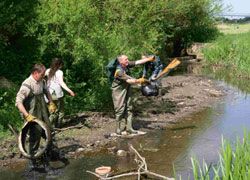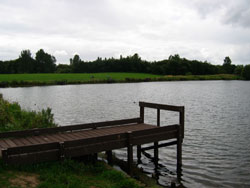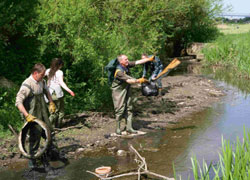Two exciting Environment Agency-led projects are just one step away from scooping national honours after reaching the finals of this year’s prestigious Waterways Renaissance Awards.
The Clean Becks Campaign and Hemlington Lakes Angling Improvements Scheme (first phase), both Middlesbrough-based, outshone a host of entries to make the last stage of The Waterways Trust and British Urban Regeneration Association-run awards, which celebrate best practice in sustainable waterway regeneration and development.
The Clean Becks Campaign is one of two finalists in the Natural England-sponsored Natural Environment category, while Hemlington Lake is up against two other schemes in the Defra-backed Community section.
Both schemes are part of the Environment Agency’s Tees Valley Project, an initiative aimed at making the environment a higher priority across the region and improving it for the benefit of both people and wildlife.
Tees Valley Project manager Mike McNulty said: “To have two schemes reach the Waterways Renaissance Awards finals is a massive boost for everyone involved. Both projects are great examples of how the Environment Agency works with partners and communities to create better places and it’s wonderful to have this effort and commitment recognised by others.”
The winners will be announced at a gala ceremony – hosted by BBC News presenter Jim Hancock – at Manchester’s Imperial War Museum North on Wednesday, 12 March.
The Clean Becks Campaign – a partnership project involving the Environment Agency, Middlesbrough Council and the Tees Valley Wildlife Trust – tackles littering and fly-tipping in the town’s becks (streams) which flow into the River Tees.
 |
| The Clean Becsk campaign targets littering and fly tipping on Middlesbrough’s streams… |
 |
| At Hemlington Lake the Environment Agency is working with professional partners and the local community to improve and promote fishing facilities and access. |
The Environment Agency recently took over responsibility for reducing flood risk from the becks and established that the vast amount of rubbish being dumped in them was one of the main causes of potential flooding. Council records showed that a staggering 30 tonnes of waste was being pulled out of Middlesbrough’s becks each month.
As part of the scheme, which is also funded by the Northumbria Flood Defence Committee, sections of the becks have been re-shaped and landscaped to allow water to flow more freely and to improve habitats. By improving these watercourses and raising awareness among local people of the problems caused by littering, the becks are becoming a healthier habitat for wildlife and the local community – and less of a flood risk.
At Hemlington Lake, a man-made flood storage reservoir connected to Bluebell Beck on the outskirts of Middlesbrough, the Environment Agency is working with professional partners and the local community to improve and promote fishing facilities and access, while continuing to protect wildlife.
Thanks to funding from the Environment Agency, Groundwork South Tees, Middlesbrough Council and the Government’s Neighbourhood Renewal Public Spaces Fund, the first phase of works included the installation of 17 fishing platforms made from recycled plastic and increased access to the lake for all visitors. Local residents have also set up ‘Friends of Hemlington Lake’ and are busy raising money to pay for promoting the lake and surrounding parkland.
The Hemlington project is generating both environmental and social benefits – healthy fish stocks are the sign of a healthy lake, while better facilities are contributing to regeneration in the area.
The Hemlington initiative faces stiff competition from the Fielden Wharf scheme in West Yorkshire, which involved demolishing a derelict building to create new green space, and the Pendle’s Canal Corridor Development Project, which regenerated rundown canalside areas in this part of Lancashire.
Meanwhile, the Clean Becks Campaign is up against the Restoration of Sinderland Brook and the Stamford Brook Development. This Cheshire project involved the de-canalisation of the brook and the creation of a new green housing development of approximately 700 homes.
Chief Executive of The Waterways Trust Roger Hanbury said: “All projects making the final list are excellent examples of what can be achieved with vision, commitment and partnership working.”
The nominations were judged by an independent assessment panel, comprising waterway, conservation and regeneration experts and chaired by the former chair of English Heritage Sir Neil Cussons.






